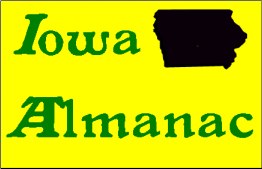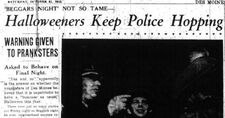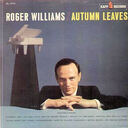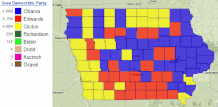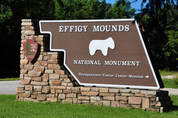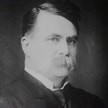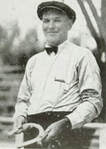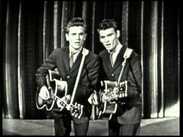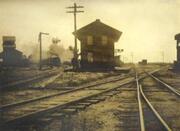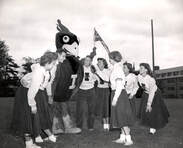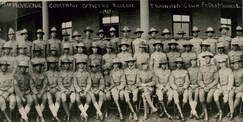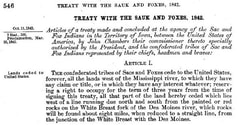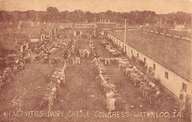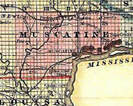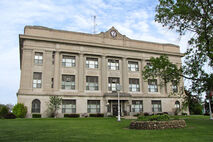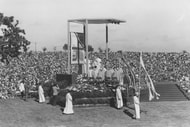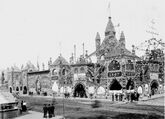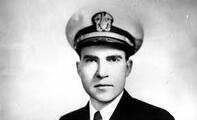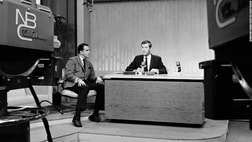"Iowa Almanac" is a copyrighted production of Stein Enterprises, L.L.C.
All Rights Reserved.
No use of the material is allowed without prior written permission of the copyright holder.
Copyright 2019 by Stein Enterprises, L.L.C.
All Rights Reserved.
No use of the material is allowed without prior written permission of the copyright holder.
Copyright 2019 by Stein Enterprises, L.L.C.
Iowa Almanac for Thursday, October 31, 2019
"First in Television"
B.J. Palmer had an idea. For people in Davenport and the Quad Cities of Iowa and Illinois, that was nothing new. The Palmer family had founded chiropractic treatment, and B.J. Palmer had seized upon the magic of radio to tell about chiropractic, leading to his founding of the first commercial radio station in Iowa in 1922.
His new idea was television. It was early in 1948, and the Palmer family announced they would put a TV station on the air from Davenport within two years. They bought a residence at 805 Brady Street to house not only their radio station, but the new television operation, as well. It was conveniently located just across the street from the Palmer College of Chiropractic.
On October 31, 1949, the 400 homes in the region with television sets got a treat on Halloween...local television...as WOC-TV signed on, on channel 5.
At the time, there were four broadcast networks--NBC, CBS, ABC, and DuMont. And since it was the only station in the region, WOC-TV carried programming from all four, although it was primarily an NBC affiliate.
By 1952, viewers enjoyed the local programming, but sometimes there was interference from another channel 5, located in Ames. As a result, the Federal Communications Commission reassigned WOC to channel 6 on the dial. That's where people first found color programming, from the network, in 1956.
The Palmer family owned the station for its first 40 years. And just as WOC-AM was the state's first radio station, WOC-TV was Iowa's first television station, going on the air in Davenport on this date in 1949…70 years ago today.
And that's Iowa Almanac for October 31st...Listen to the extended audio version of today's story by clicking on the audio player above.
"First in Television"
B.J. Palmer had an idea. For people in Davenport and the Quad Cities of Iowa and Illinois, that was nothing new. The Palmer family had founded chiropractic treatment, and B.J. Palmer had seized upon the magic of radio to tell about chiropractic, leading to his founding of the first commercial radio station in Iowa in 1922.
His new idea was television. It was early in 1948, and the Palmer family announced they would put a TV station on the air from Davenport within two years. They bought a residence at 805 Brady Street to house not only their radio station, but the new television operation, as well. It was conveniently located just across the street from the Palmer College of Chiropractic.
On October 31, 1949, the 400 homes in the region with television sets got a treat on Halloween...local television...as WOC-TV signed on, on channel 5.
At the time, there were four broadcast networks--NBC, CBS, ABC, and DuMont. And since it was the only station in the region, WOC-TV carried programming from all four, although it was primarily an NBC affiliate.
By 1952, viewers enjoyed the local programming, but sometimes there was interference from another channel 5, located in Ames. As a result, the Federal Communications Commission reassigned WOC to channel 6 on the dial. That's where people first found color programming, from the network, in 1956.
The Palmer family owned the station for its first 40 years. And just as WOC-AM was the state's first radio station, WOC-TV was Iowa's first television station, going on the air in Davenport on this date in 1949…70 years ago today.
And that's Iowa Almanac for October 31st...Listen to the extended audio version of today's story by clicking on the audio player above.
Iowa Almanac for Wednesday, October 30, 2019
"Tricks for Eats"
In the 1930s, Halloween in Des Moines was focused more on vandalism than going door to door for treats. Police there responded to a record 550 calls of vandalism in one year alone.
The director of what is now the parks and rec department, Kathryn Krieg, came up with a campaign to encourage less destructive forms of fun.
In 1938, the city set aside October 30th as Beggars’ Night, encouraging children on that night only to go door to door and say the phrase, “Tricks for Eats”. The city council said “eats should be given only if such a ‘trick’ as a song, a poem, a stunt or a musical number, either solo or in group participation, is presented.”
The Beggars’ Night program worked. By the mid-1940s, the number of Halloween police calls in Iowa’s capital city had been cut by more than half.
There was a down side, though. Some of the worst jokes and riddles ever have been told as part of the yearly event.
Kathryn Krieg retired in 1974 after 43 years on the job. Her yearly reminders to make children work for their Halloween candy were carried by local media for parts of five different decades. She died in 1999 at the age of 94, but her legacy is intact today.
The first Beggars’ Night in Des Moines, where children said “Tricks for Eats” and then were held to it, was on this date in 1938.
And that's Iowa Almanac for October 30th...Listen to the extended audio version of today's story by clicking on the audio player above.
"Tricks for Eats"
In the 1930s, Halloween in Des Moines was focused more on vandalism than going door to door for treats. Police there responded to a record 550 calls of vandalism in one year alone.
The director of what is now the parks and rec department, Kathryn Krieg, came up with a campaign to encourage less destructive forms of fun.
In 1938, the city set aside October 30th as Beggars’ Night, encouraging children on that night only to go door to door and say the phrase, “Tricks for Eats”. The city council said “eats should be given only if such a ‘trick’ as a song, a poem, a stunt or a musical number, either solo or in group participation, is presented.”
The Beggars’ Night program worked. By the mid-1940s, the number of Halloween police calls in Iowa’s capital city had been cut by more than half.
There was a down side, though. Some of the worst jokes and riddles ever have been told as part of the yearly event.
Kathryn Krieg retired in 1974 after 43 years on the job. Her yearly reminders to make children work for their Halloween candy were carried by local media for parts of five different decades. She died in 1999 at the age of 94, but her legacy is intact today.
The first Beggars’ Night in Des Moines, where children said “Tricks for Eats” and then were held to it, was on this date in 1938.
And that's Iowa Almanac for October 30th...Listen to the extended audio version of today's story by clicking on the audio player above.
Iowa Almanac for Tuesday, October 29, 2019
"Autumn Leaves Rising, Not Falling"
Early on, people in Des Moines knew Louis Weertz had talent. His father was a minister; his mother, a music teacher. The family moved to Des Moines before Louis was even a year old, and by the time he was three, he was already playing the piano…by ear.
His studies in piano at Drake University were interrupted by World War II, but he later returned to Drake and earned a masters degree. After that, it was on to the famous Julliard School. While in New York, he won a national TV talent contest. The founder of Kapp Records heard him play and signed him to a recording contract.
And that’s how Louis Weertz became known as Roger Williams.
In 1955, Roger Williams recorded “Autumn Leaves”. It became the only piano instrumental to ever reach number one on Billboard magazine’s pop music chart. It was the fourth number one song of the rock era and first moved to the top of the chart on October 29th of that year.
It stayed at number one for four weeks, and wound up being the fourth most popular song of the whole year.
Roger Williams scored 18 gold and platinum albums, and played for nine U.S. presidents, ranging from Harry S. Truman to George W. Bush.
He died of pancreatic cancer in 2011, just a week after his 87th birthday.
Iowa’s Louis Weertz—known to the world as pianist Roger Williams—went to number one on the pop charts with “Autumn Leaves”, on this date in 1955.
And that's Iowa Almanac for October 29th...Listen to the extended audio version of today's story by clicking on the audio player above.
"Autumn Leaves Rising, Not Falling"
Early on, people in Des Moines knew Louis Weertz had talent. His father was a minister; his mother, a music teacher. The family moved to Des Moines before Louis was even a year old, and by the time he was three, he was already playing the piano…by ear.
His studies in piano at Drake University were interrupted by World War II, but he later returned to Drake and earned a masters degree. After that, it was on to the famous Julliard School. While in New York, he won a national TV talent contest. The founder of Kapp Records heard him play and signed him to a recording contract.
And that’s how Louis Weertz became known as Roger Williams.
In 1955, Roger Williams recorded “Autumn Leaves”. It became the only piano instrumental to ever reach number one on Billboard magazine’s pop music chart. It was the fourth number one song of the rock era and first moved to the top of the chart on October 29th of that year.
It stayed at number one for four weeks, and wound up being the fourth most popular song of the whole year.
Roger Williams scored 18 gold and platinum albums, and played for nine U.S. presidents, ranging from Harry S. Truman to George W. Bush.
He died of pancreatic cancer in 2011, just a week after his 87th birthday.
Iowa’s Louis Weertz—known to the world as pianist Roger Williams—went to number one on the pop charts with “Autumn Leaves”, on this date in 1955.
And that's Iowa Almanac for October 29th...Listen to the extended audio version of today's story by clicking on the audio player above.
Iowa Almanac for Monday, October 28, 2019
"First in the Nation"
Ever since the first Iowa presidential precinct caucus in 1972, Iowa has become a popular place for those who seek the nation's highest office, especially since a relative unknown named Jimmy Carter used a strong showing in the 1976 event to ultimately win his party's nomination and later the presidency.
In those early days, the caucus was held in late January, and for many years, in mid to late February. But as Iowa's role in the process became more prominent, other states wanted to leapfrog Iowa and be first in the nation.
That led to party rules declaring that Iowa would be the first in the nation caucus state, and New Hampshire would host the first in the nation primary. But other states kept inching earlier and earlier, and there was a real danger that Iowa would actually have to hold its 2008 caucuses in calendar year 2007 in order to remain first.
On October 28th, 2007, representatives of the Iowa Democratic Party voted to move the caucuses to January 3rd, 2008, just about as early as possible while still being in the year of the election. Earlier in the month, our state's Republicans did the same thing, continuing a then-30-year trend of the two parties holding their respective caucuses on the same night, to maximize national exposure.
Despite threats, no other state moved ahead of Iowa, and on January 3rd, 2008, 38 percent of Iowa Democrats chose a U.S. Senator from Ilinois, Barack Obama, as their choice for president, edging former U.S. Senator John Edwards from North Carolina with 30 percent. Obama, of course, went on to win the nomination and the election to become the first non-Caucasian to hold the presidency.
The date for that historic caucus was set when Iowa Democrats moved the event to an earlier date to remain first in the nation; a decision made on this date in 2007.
And that's Iowa Almanac for October 28th...Listen to the extended audio version of today's story by clicking on the audio player above.
"First in the Nation"
Ever since the first Iowa presidential precinct caucus in 1972, Iowa has become a popular place for those who seek the nation's highest office, especially since a relative unknown named Jimmy Carter used a strong showing in the 1976 event to ultimately win his party's nomination and later the presidency.
In those early days, the caucus was held in late January, and for many years, in mid to late February. But as Iowa's role in the process became more prominent, other states wanted to leapfrog Iowa and be first in the nation.
That led to party rules declaring that Iowa would be the first in the nation caucus state, and New Hampshire would host the first in the nation primary. But other states kept inching earlier and earlier, and there was a real danger that Iowa would actually have to hold its 2008 caucuses in calendar year 2007 in order to remain first.
On October 28th, 2007, representatives of the Iowa Democratic Party voted to move the caucuses to January 3rd, 2008, just about as early as possible while still being in the year of the election. Earlier in the month, our state's Republicans did the same thing, continuing a then-30-year trend of the two parties holding their respective caucuses on the same night, to maximize national exposure.
Despite threats, no other state moved ahead of Iowa, and on January 3rd, 2008, 38 percent of Iowa Democrats chose a U.S. Senator from Ilinois, Barack Obama, as their choice for president, edging former U.S. Senator John Edwards from North Carolina with 30 percent. Obama, of course, went on to win the nomination and the election to become the first non-Caucasian to hold the presidency.
The date for that historic caucus was set when Iowa Democrats moved the event to an earlier date to remain first in the nation; a decision made on this date in 2007.
And that's Iowa Almanac for October 28th...Listen to the extended audio version of today's story by clicking on the audio player above.
Iowa Almanac for Friday, October 25, 2019
"Prehistoric Mounds"
The people we now call Native Americans inhabited the North American continent and developed integrated societies long before Europeans discovered the land.
Prehistoric earthworks by mound builder cultures are common here in the Midwest. But those mounds in the shape of effigies--mammals, birds or reptiles--were apparently constructed by those who lived on the land in what is now northeast Iowa, southern Wisconsin, and small parts of Minnesota and Illinois.
On October 25th, 1949, in an effort to preserve more than 200 prehistoric mounds built as far back as the first millennium, the Effigy Mounds National Monument was established. The federally supervised area takes in the western edge of this effigy region. The monument territory includes more than 25-hundred acres and 206 mounds, of which 31 are effigies.
The mounds themselves provide insight into the social, ceremonial, political and economic life of the Eastern Woodland people who lived there. Some are burial mounds; others were constructed to mark celestial events or season observances. Some may have been boundary markers. And some...well, we really don't know why they were constructed.
The largest, called Great Bear Mound, measures 40 yards from head to tail, and rises more than a yard above ground level.
The Effigy Mounds National Monument is located in the Driftless Area, that area of North America which escaped being altered by glaciers during the last ice age.
A visitors center leads the way to 14 miles of hiking trails; vehicles are prohibited in the area.
The Effigy Mounds National Monument, preserving remnants from a culture thousands of years old, was established on this date in 1949…70 years ago today.
And that's Iowa Almanac for October 25th...Listen to the extended audio version of today's story by clicking on the audio player above.
"Prehistoric Mounds"
The people we now call Native Americans inhabited the North American continent and developed integrated societies long before Europeans discovered the land.
Prehistoric earthworks by mound builder cultures are common here in the Midwest. But those mounds in the shape of effigies--mammals, birds or reptiles--were apparently constructed by those who lived on the land in what is now northeast Iowa, southern Wisconsin, and small parts of Minnesota and Illinois.
On October 25th, 1949, in an effort to preserve more than 200 prehistoric mounds built as far back as the first millennium, the Effigy Mounds National Monument was established. The federally supervised area takes in the western edge of this effigy region. The monument territory includes more than 25-hundred acres and 206 mounds, of which 31 are effigies.
The mounds themselves provide insight into the social, ceremonial, political and economic life of the Eastern Woodland people who lived there. Some are burial mounds; others were constructed to mark celestial events or season observances. Some may have been boundary markers. And some...well, we really don't know why they were constructed.
The largest, called Great Bear Mound, measures 40 yards from head to tail, and rises more than a yard above ground level.
The Effigy Mounds National Monument is located in the Driftless Area, that area of North America which escaped being altered by glaciers during the last ice age.
A visitors center leads the way to 14 miles of hiking trails; vehicles are prohibited in the area.
The Effigy Mounds National Monument, preserving remnants from a culture thousands of years old, was established on this date in 1949…70 years ago today.
And that's Iowa Almanac for October 25th...Listen to the extended audio version of today's story by clicking on the audio player above.
Iowa Almanac for Thursday, October 24, 2019
"The Governor for Rural Schools"
Given his birth name, he was probably destined to be in politics.
George Washington Clarke was born in Shelby County, Indiana, on October 24th, 1852. He and his family moved to a farm near Drakesville in Davis County, Iowa, when George was four years of age.
He worked on the farm in the summer, and went to school in the winter, including later walking the four miles to and from high school in Bloomfield. He became a teacher, and then went on to the State University of Iowa and obtained a law degree.
His political career began in 1900, when he was elected to the state legislature, ultimately becoming Speaker of the House. He was then twice elected as the state's lieutenant governor.
George Clarke was the Republican candidate for governor in 1912, a year when Teddy Roosevelt's Progressive party split traditional Republican vote...but Clarke overcame that and was elected to the first of three terms.
Remembering his own childhood, Governor Clarke was concerned about the quality of rural schools, since as he once said, "the necessities of farm life almost preclude the farm boy from the town high school. If he cannot come to the high school in town, then the high school must go to the country." His solution was consolidating country schools to make those that remained stronger. The plan led to more children in school, highest pay ever to that point for teachers, and newer school buildings.
Clarke retired as governor in 1917 and served as dean of the Drake Law School for a year before returning to private law practice in Adel.
Iowa's 21st governor, and one of the early advocates for rural education, George Washington Clarke, was born on this date in 1852.
And that's Iowa Almanac for October 24th...Listen to the extended audio version of today's story by clicking on the audio player above.
"The Governor for Rural Schools"
Given his birth name, he was probably destined to be in politics.
George Washington Clarke was born in Shelby County, Indiana, on October 24th, 1852. He and his family moved to a farm near Drakesville in Davis County, Iowa, when George was four years of age.
He worked on the farm in the summer, and went to school in the winter, including later walking the four miles to and from high school in Bloomfield. He became a teacher, and then went on to the State University of Iowa and obtained a law degree.
His political career began in 1900, when he was elected to the state legislature, ultimately becoming Speaker of the House. He was then twice elected as the state's lieutenant governor.
George Clarke was the Republican candidate for governor in 1912, a year when Teddy Roosevelt's Progressive party split traditional Republican vote...but Clarke overcame that and was elected to the first of three terms.
Remembering his own childhood, Governor Clarke was concerned about the quality of rural schools, since as he once said, "the necessities of farm life almost preclude the farm boy from the town high school. If he cannot come to the high school in town, then the high school must go to the country." His solution was consolidating country schools to make those that remained stronger. The plan led to more children in school, highest pay ever to that point for teachers, and newer school buildings.
Clarke retired as governor in 1917 and served as dean of the Drake Law School for a year before returning to private law practice in Adel.
Iowa's 21st governor, and one of the early advocates for rural education, George Washington Clarke, was born on this date in 1852.
And that's Iowa Almanac for October 24th...Listen to the extended audio version of today's story by clicking on the audio player above.
Iowa Almanac for Wednesday, October 23, 2019
"Championship Horseshoe Pitching"
Frank Elroy Jackson was a farmer near Kellerton, Iowa, in Ringgold County. To pass the time, he like many others enjoyed horseshoe pitching. But Frank Jackson took it to a new level.
He first got a taste of competition in 1910, just as he was turning 40 years of age. He saw how others had tossed the horseshoes, and was surprised. He had never heard of being able to hold a shoe so it would open toward the stake. Instead, he had been holding the shoe with his finger around the heel calk.
At the time, games were played on dirt or sand courts, with stakes sticking two inches high off the ground, and placed 38 feet apart. Frank Jackson had developed the skill of pitching a ringer over that two inch stake, then laying a second shoe on top of the stake so opponents could not keep their ringers on. Later, the stake height was adjusted to six inches.
Jackson took it seriously, using a pair of shoes he had specially made by a local blacksmith, who bent the calks so the shoe would slide better in the sand, and help him slide ringers on the stake.
The first national horseshoe pitching tournament was held on October 23rd, 1915, in Kansas City, Kansas. And Frank Jackson won the title. He held it for four years, and was never defeated in competition.
Wearing a battered old felt hat, a long-sleeved shirt with a skinny necktie tucked in near one of the top buttons, and unpressed pants held up by suspenders, Kellerton, Iowa’s Frank Elroy Jackson became the national horseshoe pitching champion, on this date in 1915.
And that's Iowa Almanac for October 23rd...Listen to the extended audio version of today's story by clicking on the audio player above.
"Championship Horseshoe Pitching"
Frank Elroy Jackson was a farmer near Kellerton, Iowa, in Ringgold County. To pass the time, he like many others enjoyed horseshoe pitching. But Frank Jackson took it to a new level.
He first got a taste of competition in 1910, just as he was turning 40 years of age. He saw how others had tossed the horseshoes, and was surprised. He had never heard of being able to hold a shoe so it would open toward the stake. Instead, he had been holding the shoe with his finger around the heel calk.
At the time, games were played on dirt or sand courts, with stakes sticking two inches high off the ground, and placed 38 feet apart. Frank Jackson had developed the skill of pitching a ringer over that two inch stake, then laying a second shoe on top of the stake so opponents could not keep their ringers on. Later, the stake height was adjusted to six inches.
Jackson took it seriously, using a pair of shoes he had specially made by a local blacksmith, who bent the calks so the shoe would slide better in the sand, and help him slide ringers on the stake.
The first national horseshoe pitching tournament was held on October 23rd, 1915, in Kansas City, Kansas. And Frank Jackson won the title. He held it for four years, and was never defeated in competition.
Wearing a battered old felt hat, a long-sleeved shirt with a skinny necktie tucked in near one of the top buttons, and unpressed pants held up by suspenders, Kellerton, Iowa’s Frank Elroy Jackson became the national horseshoe pitching champion, on this date in 1915.
And that's Iowa Almanac for October 23rd...Listen to the extended audio version of today's story by clicking on the audio player above.
Iowa Almanac for Tuesday, October 22, 2019
"Letterman Comes To Iowa"
In May of 2015, David Letterman ended his record-setting 33 years hosting late night TV shows. Many forget that his first TV show was on at a very different time, and had a very different audience.
The David Letterman Show aired at 9 a.m. Iowa time for a four month period in the summer and fall of 1980. It wound up winning an Emmy, but it was a little too unique for an audience used to game shows and soap operas, as opposed to a comedian with quirky humor.
As an example…the show sponsored an essay contest, encouraging viewers to write and tell why Letterman and his New York-based crew should tape an episode at your house. Jane Goldsworthy of Cresco, Iowa, submitted a 100-word essay, and before long, she found out she had won.
And that was how Howard and Jane Goldsworthy became national TV stars for a day, on October 22nd, 1980. The Letterman program that day included taped man-on-the-street segments from downtown Cresco, stupid pet tricks, and guest Cloris Leachman, herself an Iowa native.
The show almost did not make it on the air. It was taped in the late summer, and then the show was cancelled. But just before the last daytime Letterman program on October 24th, the producers made sure the Iowa episode aired, on this date, in 1980.
And that's Iowa Almanac for October 22nd...Listen to the extended audio version of today's story by clicking on the audio player above.
"Letterman Comes To Iowa"
In May of 2015, David Letterman ended his record-setting 33 years hosting late night TV shows. Many forget that his first TV show was on at a very different time, and had a very different audience.
The David Letterman Show aired at 9 a.m. Iowa time for a four month period in the summer and fall of 1980. It wound up winning an Emmy, but it was a little too unique for an audience used to game shows and soap operas, as opposed to a comedian with quirky humor.
As an example…the show sponsored an essay contest, encouraging viewers to write and tell why Letterman and his New York-based crew should tape an episode at your house. Jane Goldsworthy of Cresco, Iowa, submitted a 100-word essay, and before long, she found out she had won.
And that was how Howard and Jane Goldsworthy became national TV stars for a day, on October 22nd, 1980. The Letterman program that day included taped man-on-the-street segments from downtown Cresco, stupid pet tricks, and guest Cloris Leachman, herself an Iowa native.
The show almost did not make it on the air. It was taped in the late summer, and then the show was cancelled. But just before the last daytime Letterman program on October 24th, the producers made sure the Iowa episode aired, on this date, in 1980.
And that's Iowa Almanac for October 22nd...Listen to the extended audio version of today's story by clicking on the audio player above.
Iowa Almanac for Monday, October 21, 2019
"Iowa Brothers Top The Charts"
Given the family history, it was no surprise that Phillip and Donald Everly would turn to music. Their father, Ike, had developed a unique style of guitar playing and soon was a full-time musician. Ike and Margaret moved their family to Shenandoah so Ike could take a job performing on KMA radio. Little Donnie and Baby Boy Phil soon joined their parents on the air, when they were only 8 and 6 years old.
The Everlys lived in Shenandoah from 1945 to 1952…not long after, America knew of the brothers thanks to their first single, “Bye Bye Love”, which peaked at number 2 on the pop charts in 1957.
Their next single, though, went to the very top.
“Wake Up Little Susie” hit number one in Billboard magazine’s chart on October 21, 1957. It stayed at number one for four weeks and became their second million selling record in a row. Don was 20, Phil was 18.
The Everly Brothers were among the first 10 artists inducted into the Rock and Roll Hall of Fame. Together they had 35 Billboard Hot 100 singles…26 of those made the Top 40. But their first number one hit, “Wake Up Little Susie”, first topped the pop charts on this date in 1957.
And that's Iowa Almanac for October 21st...Listen to the extended audio version of today's story by clicking on the audio player above.
"Iowa Brothers Top The Charts"
Given the family history, it was no surprise that Phillip and Donald Everly would turn to music. Their father, Ike, had developed a unique style of guitar playing and soon was a full-time musician. Ike and Margaret moved their family to Shenandoah so Ike could take a job performing on KMA radio. Little Donnie and Baby Boy Phil soon joined their parents on the air, when they were only 8 and 6 years old.
The Everlys lived in Shenandoah from 1945 to 1952…not long after, America knew of the brothers thanks to their first single, “Bye Bye Love”, which peaked at number 2 on the pop charts in 1957.
Their next single, though, went to the very top.
“Wake Up Little Susie” hit number one in Billboard magazine’s chart on October 21, 1957. It stayed at number one for four weeks and became their second million selling record in a row. Don was 20, Phil was 18.
The Everly Brothers were among the first 10 artists inducted into the Rock and Roll Hall of Fame. Together they had 35 Billboard Hot 100 singles…26 of those made the Top 40. But their first number one hit, “Wake Up Little Susie”, first topped the pop charts on this date in 1957.
And that's Iowa Almanac for October 21st...Listen to the extended audio version of today's story by clicking on the audio player above.
Iowa Almanac for Friday, October 18, 2019
"Manly's Junction"
It's one of the most unique city names in America...while every state except Hawaii has a town named Greenville...there's only one city in the country called Manly.
The city is located in Worth County, 16 miles south of the Minnesota border, at the junction of U.S. Highway 65 and Iowa Highway 9. And the city has a history of being at a junction.
In 1877, the Burlington/Cedar Rapids & Northern Railroad, the BCR&N, joined the Central of Iowa track with its own track from Plymouth Junction. The site was named Manly Junction.
Now while it would make for a good story to suggest that the town got its name because of the strong and hardy males who lived in the region...it actually was called that because the Central of Iowa's freight agent was named J.C. Manly...so the junction of the two rail lines was naturally "Manly Junction".
On October 18, 1898, Manly Junction was officially incorporated as a town, and its name was shortened to simply Manly. Then under the new State of Iowa Home Rule Act, the town of Manly officially became the city of Manly in August 1973.
The city has a total area of just under one-and-a-half miles, and boasts just over 13-hundred citizens. Students in the Central Springs district attend school in Manly for preschool through 3rd grade, and again from 8th through 12th grade.
Ironically, there are now 53 percent women and only 47 percent men living there...but no matter...the town of Manly was incorporated on this date in 1898.
And that's Iowa Almanac for October 18th...Listen to the extended audio version of today's story by clicking on the audio player above.
"Manly's Junction"
It's one of the most unique city names in America...while every state except Hawaii has a town named Greenville...there's only one city in the country called Manly.
The city is located in Worth County, 16 miles south of the Minnesota border, at the junction of U.S. Highway 65 and Iowa Highway 9. And the city has a history of being at a junction.
In 1877, the Burlington/Cedar Rapids & Northern Railroad, the BCR&N, joined the Central of Iowa track with its own track from Plymouth Junction. The site was named Manly Junction.
Now while it would make for a good story to suggest that the town got its name because of the strong and hardy males who lived in the region...it actually was called that because the Central of Iowa's freight agent was named J.C. Manly...so the junction of the two rail lines was naturally "Manly Junction".
On October 18, 1898, Manly Junction was officially incorporated as a town, and its name was shortened to simply Manly. Then under the new State of Iowa Home Rule Act, the town of Manly officially became the city of Manly in August 1973.
The city has a total area of just under one-and-a-half miles, and boasts just over 13-hundred citizens. Students in the Central Springs district attend school in Manly for preschool through 3rd grade, and again from 8th through 12th grade.
Ironically, there are now 53 percent women and only 47 percent men living there...but no matter...the town of Manly was incorporated on this date in 1898.
And that's Iowa Almanac for October 18th...Listen to the extended audio version of today's story by clicking on the audio player above.
Iowa Almanac for Thursday, October 17, 2019
"A Day Of Her Own"
Not every high school sophomore has the Iowa governor declare a day in her honor.
But not every high school sophomore had just won the title of all-around world gymnastics champion, either.
October 17, 2007, was Shawn Johnson Day in Iowa. The 15-year-old was honored following one of the best rookie seasons ever recorded in the history of gymnastics. She won the all-around title at the American Cup...the Pan American Games, U.S. National Championships, and World Championships, all in her first year as a senior-level gymnast.
By that time, she had been taking gymnastics classes for a dozen years, from the time she was three years of age.
Then came 2008, an Olympic year. Johnson again won the all-around title at the U.S. Nationals, and at the Olympic Trials. The U.S. team won silver at the Beijing games, and Shawn Johnson won silver in the individual all-around, as well. She also took home gold in the balance beam, and silver in floor exercise.
Then she won season eight of "Dancing With the Stars" the following spring...all that, at barely 17 years of age.
She's been honored in a number of ways in her home state, including with a life-sized bronze sculpture at the Iowa Hall of Pride in Des Moines. But all Iowa celebrated her, on "Shawn Johnson Day" in the state, on this date in 2007.
And that's Iowa Almanac for October 17th...Listen to the extended audio version of today's story by clicking on the audio player above.
"A Day Of Her Own"
Not every high school sophomore has the Iowa governor declare a day in her honor.
But not every high school sophomore had just won the title of all-around world gymnastics champion, either.
October 17, 2007, was Shawn Johnson Day in Iowa. The 15-year-old was honored following one of the best rookie seasons ever recorded in the history of gymnastics. She won the all-around title at the American Cup...the Pan American Games, U.S. National Championships, and World Championships, all in her first year as a senior-level gymnast.
By that time, she had been taking gymnastics classes for a dozen years, from the time she was three years of age.
Then came 2008, an Olympic year. Johnson again won the all-around title at the U.S. Nationals, and at the Olympic Trials. The U.S. team won silver at the Beijing games, and Shawn Johnson won silver in the individual all-around, as well. She also took home gold in the balance beam, and silver in floor exercise.
Then she won season eight of "Dancing With the Stars" the following spring...all that, at barely 17 years of age.
She's been honored in a number of ways in her home state, including with a life-sized bronze sculpture at the Iowa Hall of Pride in Des Moines. But all Iowa celebrated her, on "Shawn Johnson Day" in the state, on this date in 2007.
And that's Iowa Almanac for October 17th...Listen to the extended audio version of today's story by clicking on the audio player above.
Iowa Almanac for Wednesday, October 16, 2019
"Cy Takes The Field"
The Iowa State athletic teams have been known as the Cyclones since 1895. That’s when the Chicago Tribune said the Northwestern football team had been “struck by a cyclone” when the team from Ames came to town. The name stuck.
But it’s hard to have a cyclone as a mascot. After all, what costume would you come up with?
In 1954, members of Iowa State’s Pep Council decided the university needed a mascot. They decided on a cardinal, since the school colors are cardinal and gold. A contest was held to name the new mascot, and 17 people submitted the name “Cy”, short for “Cyclone”.
Cy the Cardinal made his debut at Homecoming on October 16, 1954. That first Cy was 8 feet tall and the costume cost $200 to create.
A slightly more agile version of the mascot, named Clone, debuted in 1989. Cy and Clone both served for a number of years, before being merged in 1995 into the Cy who prowls the sidelines on game day today.
Cy the Cardinal won a national mascot of the year contest in 2008, but he made his debut at Homecoming, on this date, in 1954…65 years ago today.
And that's Iowa Almanac for October 16th...Listen to the extended audio version of today's story by clicking on the audio player above.
"Cy Takes The Field"
The Iowa State athletic teams have been known as the Cyclones since 1895. That’s when the Chicago Tribune said the Northwestern football team had been “struck by a cyclone” when the team from Ames came to town. The name stuck.
But it’s hard to have a cyclone as a mascot. After all, what costume would you come up with?
In 1954, members of Iowa State’s Pep Council decided the university needed a mascot. They decided on a cardinal, since the school colors are cardinal and gold. A contest was held to name the new mascot, and 17 people submitted the name “Cy”, short for “Cyclone”.
Cy the Cardinal made his debut at Homecoming on October 16, 1954. That first Cy was 8 feet tall and the costume cost $200 to create.
A slightly more agile version of the mascot, named Clone, debuted in 1989. Cy and Clone both served for a number of years, before being merged in 1995 into the Cy who prowls the sidelines on game day today.
Cy the Cardinal won a national mascot of the year contest in 2008, but he made his debut at Homecoming, on this date, in 1954…65 years ago today.
And that's Iowa Almanac for October 16th...Listen to the extended audio version of today's story by clicking on the audio player above.
Iowa Almanac for Tuesday, October 15, 2019
"Graduating Cadets"
The United States entered World War I in 1917, and thousands of Americans enlisted to fight Germany in the Great War. That included thousands of black Americans, from all parts of the country.
Keep in mind this was only 50 years after the end of the U.S. Civil War.
Despite the eagerness of some blacks to join the fight, enlistments were limited by the federal government. While some groups such as the NAACP pushed for officer training for blacks, government officials were afraid the race issue would hurt the war effort.
So a compromise was reached, whereby one officer candidate school in the country would be open to blacks. It was located at Fort Des Moines.
Fort Des Moines had been built on 400 acres of land in 1901 and had previously hosted all-black units for training.
The first black officer candidates arrived at Fort Des Moines in May of 1917, consisting of 1,000 black college graduates and faculty members. At the time, Des Moines’ black population only numbered 5,000.
The troops were highly educated, and well received by the community. That was in contrast to an all-black Alabama enlisted regiment based at Camp Dodge across town, which often faced discrimination.
After 90 days of rigorous training, 638 captains and lieutenants received their commissions and were dispatched for basic training across the country. They would reunite in New Jersey in June of the next year, to fight as a unit in France.
Graduation day for the country’s only class of black officers, trained at Fort Des Moines, happened on this date in 1917.
And that's Iowa Almanac for October 15th...Listen to the extended audio version of today's story by clicking on the audio player above.
"Graduating Cadets"
The United States entered World War I in 1917, and thousands of Americans enlisted to fight Germany in the Great War. That included thousands of black Americans, from all parts of the country.
Keep in mind this was only 50 years after the end of the U.S. Civil War.
Despite the eagerness of some blacks to join the fight, enlistments were limited by the federal government. While some groups such as the NAACP pushed for officer training for blacks, government officials were afraid the race issue would hurt the war effort.
So a compromise was reached, whereby one officer candidate school in the country would be open to blacks. It was located at Fort Des Moines.
Fort Des Moines had been built on 400 acres of land in 1901 and had previously hosted all-black units for training.
The first black officer candidates arrived at Fort Des Moines in May of 1917, consisting of 1,000 black college graduates and faculty members. At the time, Des Moines’ black population only numbered 5,000.
The troops were highly educated, and well received by the community. That was in contrast to an all-black Alabama enlisted regiment based at Camp Dodge across town, which often faced discrimination.
After 90 days of rigorous training, 638 captains and lieutenants received their commissions and were dispatched for basic training across the country. They would reunite in New Jersey in June of the next year, to fight as a unit in France.
Graduation day for the country’s only class of black officers, trained at Fort Des Moines, happened on this date in 1917.
And that's Iowa Almanac for October 15th...Listen to the extended audio version of today's story by clicking on the audio player above.
Iowa Almanac for Monday, October 14, 2019
"A Fruit Pie"
Anita Bryant was known in the 1950s and 1960s as a singer, then as the commercial spokesperson for Florida orange juice.
By the mid-1970s, she became active in the anti-gay rights movement, first in Florida, and then around the country.
That's what led her to come to Des Moines on August 14th, 1977. Only two months before, her efforts led to repeal of an anti-discrimination ordinance in her home state. She was speaking at a news conference when suddenly a gay rights activist from Minnesota named Thom Higgins hit Bryant in the face with a cream pie.
Immediately afterward, Bryant and her husband Bob Green prayed for God to forgive the activist for his deviant lifestyle. Higgins was one of four who attended the news conference to protest against Bryant. They brought with them a spare pie. Bryant's husband confronted the four outside the news conference, and tossed that spare pie into the face of one of the protestors.
No charges were filed.
It's been more than 40 years, and the issue of gay rights still raises controversy. One of the most public displays of the dispute came in Des Moines when Anita Bryant was hit in the face with a pie by a gay rights activist, on this date, in 1977.
And that's Iowa Almanac for October 14th...Listen to the extended audio version of today's story by clicking on the audio player above.
"A Fruit Pie"
Anita Bryant was known in the 1950s and 1960s as a singer, then as the commercial spokesperson for Florida orange juice.
By the mid-1970s, she became active in the anti-gay rights movement, first in Florida, and then around the country.
That's what led her to come to Des Moines on August 14th, 1977. Only two months before, her efforts led to repeal of an anti-discrimination ordinance in her home state. She was speaking at a news conference when suddenly a gay rights activist from Minnesota named Thom Higgins hit Bryant in the face with a cream pie.
Immediately afterward, Bryant and her husband Bob Green prayed for God to forgive the activist for his deviant lifestyle. Higgins was one of four who attended the news conference to protest against Bryant. They brought with them a spare pie. Bryant's husband confronted the four outside the news conference, and tossed that spare pie into the face of one of the protestors.
No charges were filed.
It's been more than 40 years, and the issue of gay rights still raises controversy. One of the most public displays of the dispute came in Des Moines when Anita Bryant was hit in the face with a pie by a gay rights activist, on this date, in 1977.
And that's Iowa Almanac for October 14th...Listen to the extended audio version of today's story by clicking on the audio player above.
Iowa Almanac for Friday, October 11, 2019
"A Final Treaty"
The Sac and Fox tribe of the Mississippi in Iowa owned and held about three-quarters of the land making up the current state of Iowa in 1842. As part of continued U.S. government intervention, on October 11th of that year, a treaty was signed between tribal leaders and the government, whereby the Native Americans would give up all that land west of the Mississippi and move to a 34 by 20 mile band of land in Kansas. It would take three years for the migration to take place.
The government agreed on paper to pay for the land, some $800,000. That would be close to $18 million today. Each principal chief of the tribe was to receive $500 annually, as well.
As was often the case in the time, those who sold the land had a difficult time getting payment from the U.S. government.
Some well known names signed off on the treaty...names that would become known today as county or city names; Keokuk, Poweshiek, Appanoose, and others.
The land in Kansas was hardly as bountiful as that in Iowa. Less than a generation later, in 1857, a group of Sac and Fox moved back to Iowa, buying 80 acres of land in Tama County and establishing a settlement free from regulation, as opposed to reservations on land provided by government.
But the treaty that led to the Sac and Fox giving up their land, some three-quarters of the state of Iowa, was signed on this date in 1842.
And that's Iowa Almanac for October 11th...Listen to the extended audio version of today's story by clicking on the audio player above.
"A Final Treaty"
The Sac and Fox tribe of the Mississippi in Iowa owned and held about three-quarters of the land making up the current state of Iowa in 1842. As part of continued U.S. government intervention, on October 11th of that year, a treaty was signed between tribal leaders and the government, whereby the Native Americans would give up all that land west of the Mississippi and move to a 34 by 20 mile band of land in Kansas. It would take three years for the migration to take place.
The government agreed on paper to pay for the land, some $800,000. That would be close to $18 million today. Each principal chief of the tribe was to receive $500 annually, as well.
As was often the case in the time, those who sold the land had a difficult time getting payment from the U.S. government.
Some well known names signed off on the treaty...names that would become known today as county or city names; Keokuk, Poweshiek, Appanoose, and others.
The land in Kansas was hardly as bountiful as that in Iowa. Less than a generation later, in 1857, a group of Sac and Fox moved back to Iowa, buying 80 acres of land in Tama County and establishing a settlement free from regulation, as opposed to reservations on land provided by government.
But the treaty that led to the Sac and Fox giving up their land, some three-quarters of the state of Iowa, was signed on this date in 1842.
And that's Iowa Almanac for October 11th...Listen to the extended audio version of today's story by clicking on the audio player above.
Iowa Almanac for Thursday, October 10, 2019
"Congress In Session...In Waterloo"
In the early part of the last century, the Iowa State Dairy Association started holding dairy cow exhibitions as part of the group's annual meeting. The first year, in 1909, two dozen cows were exhibited during the meeting in Cedar Rapids.
On October 10th, 1910, the dairy cow exhibition was moved to Waterloo's Chautauqua Park. More than 5,000 people attended the exhibition show, which featured 62 cows.
The success of that Waterloo event led to the formation of the Dairy Cattle Congress as a way to develop the dairy industry and promote it to the public.
The event's organizer was Hugh Van Pelt, a professor at Iowa State University. There were other shows starting up at the same time, in Chicago and Milwaukee. But quickly, the show in Waterloo became the premiere national event, with local business people putting up prize money--the largest amount ever offered in the U.S. for a similar event at the time.
Since 1912, the event has been held at the same spot in downtown Waterloo, and has been held every year since except for weather and war...and even weather hasn't always stopped the Cattle Congress. In 1925, a windstorm destroyed three original wooden barns just before the show. A local construction company rallied all the stone masons, bricklayers, and carpenters in the area, and within a week, the wrecked barns were replaced with brick barns that are still used today.
An old promotional poster once noted that "Congress entertainment is educational...it's education is entertaining...it is ALL inspirational".
The current Cattle Congress grounds operate year-round with a variety of events held in several multipurpose buildings, including the Hippodrome and the Electric Park Ballroom. And each year's event also now features general entertainment and a midway. But the first national Dairy Cattle Congress held in Waterloo began on this date in 1910.
And that's Iowa Almanac for October 10th...Listen to the extended audio version of today's story by clicking on the audio player above.
"Congress In Session...In Waterloo"
In the early part of the last century, the Iowa State Dairy Association started holding dairy cow exhibitions as part of the group's annual meeting. The first year, in 1909, two dozen cows were exhibited during the meeting in Cedar Rapids.
On October 10th, 1910, the dairy cow exhibition was moved to Waterloo's Chautauqua Park. More than 5,000 people attended the exhibition show, which featured 62 cows.
The success of that Waterloo event led to the formation of the Dairy Cattle Congress as a way to develop the dairy industry and promote it to the public.
The event's organizer was Hugh Van Pelt, a professor at Iowa State University. There were other shows starting up at the same time, in Chicago and Milwaukee. But quickly, the show in Waterloo became the premiere national event, with local business people putting up prize money--the largest amount ever offered in the U.S. for a similar event at the time.
Since 1912, the event has been held at the same spot in downtown Waterloo, and has been held every year since except for weather and war...and even weather hasn't always stopped the Cattle Congress. In 1925, a windstorm destroyed three original wooden barns just before the show. A local construction company rallied all the stone masons, bricklayers, and carpenters in the area, and within a week, the wrecked barns were replaced with brick barns that are still used today.
An old promotional poster once noted that "Congress entertainment is educational...it's education is entertaining...it is ALL inspirational".
The current Cattle Congress grounds operate year-round with a variety of events held in several multipurpose buildings, including the Hippodrome and the Electric Park Ballroom. And each year's event also now features general entertainment and a midway. But the first national Dairy Cattle Congress held in Waterloo began on this date in 1910.
And that's Iowa Almanac for October 10th...Listen to the extended audio version of today's story by clicking on the audio player above.
Iowa Almanac for Wednesday, October 9, 2019
"Up, Up And Away"
We take air travel for granted these days, but it wasn’t that long ago that soaring through the sky was quite a novelty.
While the first public demonstration of an unmanned hot air balloon was in France in 1783, it took 62 years before a similar event occurred in Iowa. It was for Independence Day 1845, and an unmanned balloon was sent aloft in Burlington, staying in the sky for close to an hour.
On October 9th, 1856, some 15,000 people gathered in Muscatine for the third Iowa State Fair. Among that day’s attractions was the first manned balloon ascension ever in the state.
The balloon was owned by Silas M. Brooks, and was called Hercules. Newspapers called the event “entertainment with a very heavy expense” and “the greatest novelty that has ever visited this city”.
At around 4:30 p.m., the balloon began to rise and a male known now only as Mr. Leonard climbed into the basket. He drifted for 45 minutes, coming back to earth in Cedar County, three miles north of Wilton and fifteen miles from where he started in Muscatine.
The state’s first manned balloon ascension, a highlight of the third Iowa State Fair in Muscatine, happened on this date in 1856.
And that's Iowa Almanac for October 9th...Listen to the extended audio version of today's story by clicking on the audio player above.
"Up, Up And Away"
We take air travel for granted these days, but it wasn’t that long ago that soaring through the sky was quite a novelty.
While the first public demonstration of an unmanned hot air balloon was in France in 1783, it took 62 years before a similar event occurred in Iowa. It was for Independence Day 1845, and an unmanned balloon was sent aloft in Burlington, staying in the sky for close to an hour.
On October 9th, 1856, some 15,000 people gathered in Muscatine for the third Iowa State Fair. Among that day’s attractions was the first manned balloon ascension ever in the state.
The balloon was owned by Silas M. Brooks, and was called Hercules. Newspapers called the event “entertainment with a very heavy expense” and “the greatest novelty that has ever visited this city”.
At around 4:30 p.m., the balloon began to rise and a male known now only as Mr. Leonard climbed into the basket. He drifted for 45 minutes, coming back to earth in Cedar County, three miles north of Wilton and fifteen miles from where he started in Muscatine.
The state’s first manned balloon ascension, a highlight of the third Iowa State Fair in Muscatine, happened on this date in 1856.
And that's Iowa Almanac for October 9th...Listen to the extended audio version of today's story by clicking on the audio player above.
Iowa Almanac for Tuesday, October 8, 2019
"Dedicating A Courthouse"
Fayette County in northeast Iowa has a unique history. It's named for the French general aiding the Colonists in the Revolutionary War, the Marquis de la Fayette.
And it was originally one of the largest counties ever organized. It had an area of 140,000 square miles and included all of the present state of Minnesota west of the Mississippi River. In fact, almost all of the counties in northeastern Iowa were formed out of the original Fayette County, which was reduced to its current boundaries in 1847, shortly after Iowa became a state.
Back in 1851, a vote was held to determine where the county seat would be. Voters had six choices, with the top two advancing to a later ballot when the final choice would be made. Voters chose West Union over Lightville.
The county seat of West Union was originally called Knob Prairie. And although a courthouse was proposed in 1853, one was not built until three years later. County business was transacted in the Methodist Church until the courthouse was ready.
But that original building burned to the ground when a prisoner in the jail started his cell on fire. A second courthouse was then built...but it was destroyed by fire, as well in 1922.
Before a third courthouse could be built, there was another fight over where the county seat should be located. Fayette and Oelwein made their respective cases, but again, West Union prevailed, in part because citizens of West Union and the surrounding areas donated $100,000 toward the total building cost of almost $300,000. But after losing the previous two courthouses due to fire, this one is a gray Bedford stone structure.
This version of the Fayette County Courthouse was formally dedicated and open for business, on this date in 1924.
And that's Iowa Almanac for October 8th...Listen to the extended audio version of today's story by clicking on the audio player above.
"Dedicating A Courthouse"
Fayette County in northeast Iowa has a unique history. It's named for the French general aiding the Colonists in the Revolutionary War, the Marquis de la Fayette.
And it was originally one of the largest counties ever organized. It had an area of 140,000 square miles and included all of the present state of Minnesota west of the Mississippi River. In fact, almost all of the counties in northeastern Iowa were formed out of the original Fayette County, which was reduced to its current boundaries in 1847, shortly after Iowa became a state.
Back in 1851, a vote was held to determine where the county seat would be. Voters had six choices, with the top two advancing to a later ballot when the final choice would be made. Voters chose West Union over Lightville.
The county seat of West Union was originally called Knob Prairie. And although a courthouse was proposed in 1853, one was not built until three years later. County business was transacted in the Methodist Church until the courthouse was ready.
But that original building burned to the ground when a prisoner in the jail started his cell on fire. A second courthouse was then built...but it was destroyed by fire, as well in 1922.
Before a third courthouse could be built, there was another fight over where the county seat should be located. Fayette and Oelwein made their respective cases, but again, West Union prevailed, in part because citizens of West Union and the surrounding areas donated $100,000 toward the total building cost of almost $300,000. But after losing the previous two courthouses due to fire, this one is a gray Bedford stone structure.
This version of the Fayette County Courthouse was formally dedicated and open for business, on this date in 1924.
And that's Iowa Almanac for October 8th...Listen to the extended audio version of today's story by clicking on the audio player above.
Iowa Almanac for Monday, October 7, 2019
"Writing A Constitution"
The procedure was fairly straight forward…in order for a territory to become a state, a constitution had to be written.
And that led to a gathering of 72 men in Iowa City on October 7th, 1844. Iowa had been a territory for six years, but the concept of writing a constitution or making laws was still new.
Two thirds of the delegates were Democrats, the rest were Whigs. The Republican party wouldn’t be formed for another ten years.
The convention was in session for 26 days, discussing questions such as “should meetings be opened with prayer?”, “what salaries should be paid to public officials?” and “what should be the boundaries of the new state?”.
The constitution was ultimately sent to Congress in December, which had to determine if Iowa’s population was large enough to justify statehood, if the boundaries for the proposed new state were satisfactory, and if the constitution itself was consistent with the U.S. Constitution.
Congress approved the document, including that Iowa would enter the union as a free state. But the people of Iowa had to vote and approve the constitution. As it turned out, citizens did not like the boundaries that had been proposed, and rejected the constitution.
That delayed Iowa statehood, because another convention had to be called and another document prepared for approval by voters. That ultimately happened, of course. But the first constitutional convention for Iowa statehood began on this date in 1844.
And that's Iowa Almanac for October 7th...Listen to the extended audio version of today's story by clicking on the audio player above.
"Writing A Constitution"
The procedure was fairly straight forward…in order for a territory to become a state, a constitution had to be written.
And that led to a gathering of 72 men in Iowa City on October 7th, 1844. Iowa had been a territory for six years, but the concept of writing a constitution or making laws was still new.
Two thirds of the delegates were Democrats, the rest were Whigs. The Republican party wouldn’t be formed for another ten years.
The convention was in session for 26 days, discussing questions such as “should meetings be opened with prayer?”, “what salaries should be paid to public officials?” and “what should be the boundaries of the new state?”.
The constitution was ultimately sent to Congress in December, which had to determine if Iowa’s population was large enough to justify statehood, if the boundaries for the proposed new state were satisfactory, and if the constitution itself was consistent with the U.S. Constitution.
Congress approved the document, including that Iowa would enter the union as a free state. But the people of Iowa had to vote and approve the constitution. As it turned out, citizens did not like the boundaries that had been proposed, and rejected the constitution.
That delayed Iowa statehood, because another convention had to be called and another document prepared for approval by voters. That ultimately happened, of course. But the first constitutional convention for Iowa statehood began on this date in 1844.
And that's Iowa Almanac for October 7th...Listen to the extended audio version of today's story by clicking on the audio player above.
Iowa Almanac for Friday, October 4, 2019
"The Pope Comes to Iowa"
In 1979, the new Pope, John Paul the Second, announced a trip to the United States including an address before the United Nations in New York. But Truro farmer Joe Hays thought it was important for the Pope to visit the Midwest, so he hand wrote a two-page letter to the pontiff, personally inviting him to visit "rural America, the heartland and breadbasket of our nation" while on his tour.
To his surprise, he received a reply from the Vatican. The Pope had accepted his invitation, and added a stop in Iowa.
The crowd began to gather the day before, and bus trips of the faithful flocked to Living History Farms to hear the Pope deliver his homily from a simple white oak altar.
No event in Iowa history had ever drawn as many people to one place; more than 350,000 by most estimates.
The Pope arrived via helicopter, and promptly kneeled and kissed the ground. He blessed farmers as stewards of the land and urged them to help end famine in the world.
By the time of his death in 2005, Pope John Paul II had led the Catholic Church for nearly 27 years, and since has been elevated to sainthood. But when Iowans saw him, he had not even been pontiff for a full year. It was a bright and crisp afternoon when 350,000 saw the Pope officiate an outdoor mass near Des Moines, on this date in 1979.
And that's Iowa Almanac for October 4th...Listen to the extended audio version of today's story by clicking on the audio player above.
"The Pope Comes to Iowa"
In 1979, the new Pope, John Paul the Second, announced a trip to the United States including an address before the United Nations in New York. But Truro farmer Joe Hays thought it was important for the Pope to visit the Midwest, so he hand wrote a two-page letter to the pontiff, personally inviting him to visit "rural America, the heartland and breadbasket of our nation" while on his tour.
To his surprise, he received a reply from the Vatican. The Pope had accepted his invitation, and added a stop in Iowa.
The crowd began to gather the day before, and bus trips of the faithful flocked to Living History Farms to hear the Pope deliver his homily from a simple white oak altar.
No event in Iowa history had ever drawn as many people to one place; more than 350,000 by most estimates.
The Pope arrived via helicopter, and promptly kneeled and kissed the ground. He blessed farmers as stewards of the land and urged them to help end famine in the world.
By the time of his death in 2005, Pope John Paul II had led the Catholic Church for nearly 27 years, and since has been elevated to sainthood. But when Iowans saw him, he had not even been pontiff for a full year. It was a bright and crisp afternoon when 350,000 saw the Pope officiate an outdoor mass near Des Moines, on this date in 1979.
And that's Iowa Almanac for October 4th...Listen to the extended audio version of today's story by clicking on the audio player above.
Iowa Almanac for Thursday, October 3, 2019
"Iowa's Corn Palace"
Iowa is the corn state, and over time, we've celebrated our top crop in a number of ways.
In Sioux City, one of those ways was to build a building and hold a festival. So in 1887, they built a building with more than 18,000 square feet of floor space, at a cost of $25,000. Every inch of the outside of the wooden structure was covered with corn and grain. Ears of brightly colored so-called Indian corn were sliced and nailed into fancy patterns, and above each arched doorway, a farming scene was created from corn and grain. Even sorghum and cattails were used in the designs.
The women of Sioux City were invited to decorate the inside, including a map of the United States with each state made of a different color of grains and seeds. Murals covered the walls showing natural scenes.
The first Corn Palace Festival opened on October 3rd, 1887. Nearly 140,000 people attended, including President Grover Cleveland, who came by special train to see the Corn Palace the day after the festival ended.
Another year, another festival, with new designs all made from corn. Attendance had started to slip after the fifth year though, and then in the spring of 1892, the Great Floyd River Flood devastated Sioux City. Organizers decided to use the money that would have gone toward building a new corn palace for flood relief.
When folks in Mitchell, South Dakota realized Sioux City was not going to build a corn palace that year, they built one of their own. It's become a world-renowned tourist attraction. Sioux City never did build another corn palace, as the flood year gave way to a national financial panic the next, and then the idea was lost.
But for five years, Sioux City's Corn Palace was a bright spot of the harvest season. And the first palace and festival opened on this date in 1887.
And that's Iowa Almanac for October 3rd...Listen to the extended audio version of today's story by clicking on the audio player above.
"Iowa's Corn Palace"
Iowa is the corn state, and over time, we've celebrated our top crop in a number of ways.
In Sioux City, one of those ways was to build a building and hold a festival. So in 1887, they built a building with more than 18,000 square feet of floor space, at a cost of $25,000. Every inch of the outside of the wooden structure was covered with corn and grain. Ears of brightly colored so-called Indian corn were sliced and nailed into fancy patterns, and above each arched doorway, a farming scene was created from corn and grain. Even sorghum and cattails were used in the designs.
The women of Sioux City were invited to decorate the inside, including a map of the United States with each state made of a different color of grains and seeds. Murals covered the walls showing natural scenes.
The first Corn Palace Festival opened on October 3rd, 1887. Nearly 140,000 people attended, including President Grover Cleveland, who came by special train to see the Corn Palace the day after the festival ended.
Another year, another festival, with new designs all made from corn. Attendance had started to slip after the fifth year though, and then in the spring of 1892, the Great Floyd River Flood devastated Sioux City. Organizers decided to use the money that would have gone toward building a new corn palace for flood relief.
When folks in Mitchell, South Dakota realized Sioux City was not going to build a corn palace that year, they built one of their own. It's become a world-renowned tourist attraction. Sioux City never did build another corn palace, as the flood year gave way to a national financial panic the next, and then the idea was lost.
But for five years, Sioux City's Corn Palace was a bright spot of the harvest season. And the first palace and festival opened on this date in 1887.
And that's Iowa Almanac for October 3rd...Listen to the extended audio version of today's story by clicking on the audio player above.
Iowa Almanac for Wednesday, October 2, 2019
"Navy Pilots in Iowa"
America entered the Second World War when Pearl Harbor was attacked on December 7, 1941. All aspects of American society were mobilized.
Five months later, in April 1942, a U.S. Navy site selection board met in Ottumwa with city officials and the head of the airport commission there. The board determined that Ottumwa was well suited as the site for a primary training location, and on July 9th of that year, Navy Secretary Frank Knox announced approved of Ottumwa as site of a naval aviation base.
The Navy took possession of a 14-hundred acre tract of land for the air base, which was under the direction of Lt. Comdr. D.D. Gurley. On September 13th, the first two enlisted men reported for duty.
Lt. Comdr. Gurley himself landed the first Navy airplane at the base on January 23rd, 1943. Flight training for cadets began in March. That summer, some 30,000 civilians toured the new base during an open house.
Over time, more than 66-hundred trainees reported for duty in Ottumwa, including Ensign Richard Nixon in October of 1942. They flew nearly 400-thousand training flights before flight training officially ended in September of 1945. The base was used for midshipmen training after the war, and then was closed when operations moved to Florida two years later.
The Naval Air Station at Ottumwa trained thousands of pilots during World War II before the last U.S. Navy airplane left Ottumwa, on this date, in 1947.
And that's Iowa Almanac for October 2nd...Listen to the extended audio version of today's story by clicking on the audio player above.
"Navy Pilots in Iowa"
America entered the Second World War when Pearl Harbor was attacked on December 7, 1941. All aspects of American society were mobilized.
Five months later, in April 1942, a U.S. Navy site selection board met in Ottumwa with city officials and the head of the airport commission there. The board determined that Ottumwa was well suited as the site for a primary training location, and on July 9th of that year, Navy Secretary Frank Knox announced approved of Ottumwa as site of a naval aviation base.
The Navy took possession of a 14-hundred acre tract of land for the air base, which was under the direction of Lt. Comdr. D.D. Gurley. On September 13th, the first two enlisted men reported for duty.
Lt. Comdr. Gurley himself landed the first Navy airplane at the base on January 23rd, 1943. Flight training for cadets began in March. That summer, some 30,000 civilians toured the new base during an open house.
Over time, more than 66-hundred trainees reported for duty in Ottumwa, including Ensign Richard Nixon in October of 1942. They flew nearly 400-thousand training flights before flight training officially ended in September of 1945. The base was used for midshipmen training after the war, and then was closed when operations moved to Florida two years later.
The Naval Air Station at Ottumwa trained thousands of pilots during World War II before the last U.S. Navy airplane left Ottumwa, on this date, in 1947.
And that's Iowa Almanac for October 2nd...Listen to the extended audio version of today's story by clicking on the audio player above.
Iowa Almanac for Tuesday, October 1, 2019
"The King Assumes His Throne"
Here's Johnny!
John William Carson was born in Corning, Iowa on October 23, 1925. And it was on this date, October 1st in 1962, that 36-year-old Johnny Carson first took the stage as host of NBC's Tonight Show program.
For the next 30 years, Carson dominated late night TV as no one else has, before or since. His nightly monologue was required viewing and helped reflect, and set, the national mood on politics, pop culture, and life in our times generally.
Carson also lived in Clarinda, Avoca, and Red Oak, Iowa, before his family moved to Norfolk, Nebraska when Johnny was 8 years old. He taught himself magic, and often performed as a teen as the Great Carsoni.
The love of entertaining led him to the still new world of broadcasting, first in Omaha and then Los Angeles, where in 1950 he got his first comedy show, Carson's Cellar.
Soon it was on to New York to host a series of game shows while also filling in as host of other programs, including substituting for Jack Paar on his version of the Tonight Show.
The king of late night, Carson presided over the Tonight Show in parts of four different decades, and gave countless comedians and entertainers their big break on his program.
It's hard to believe it's been more than 25 years since he left television, but in a testament to the popularity of his work, reruns of the original programs from the 1970s and 1980s air nightly on TV stations across the country.
The first Tonight Show starring Iowa's Johnny Carson took to the air, on this date, in 1962.
And that's Iowa Almanac for October 1st...Listen to the extended audio version of today's story by clicking on the audio player above.
"The King Assumes His Throne"
Here's Johnny!
John William Carson was born in Corning, Iowa on October 23, 1925. And it was on this date, October 1st in 1962, that 36-year-old Johnny Carson first took the stage as host of NBC's Tonight Show program.
For the next 30 years, Carson dominated late night TV as no one else has, before or since. His nightly monologue was required viewing and helped reflect, and set, the national mood on politics, pop culture, and life in our times generally.
Carson also lived in Clarinda, Avoca, and Red Oak, Iowa, before his family moved to Norfolk, Nebraska when Johnny was 8 years old. He taught himself magic, and often performed as a teen as the Great Carsoni.
The love of entertaining led him to the still new world of broadcasting, first in Omaha and then Los Angeles, where in 1950 he got his first comedy show, Carson's Cellar.
Soon it was on to New York to host a series of game shows while also filling in as host of other programs, including substituting for Jack Paar on his version of the Tonight Show.
The king of late night, Carson presided over the Tonight Show in parts of four different decades, and gave countless comedians and entertainers their big break on his program.
It's hard to believe it's been more than 25 years since he left television, but in a testament to the popularity of his work, reruns of the original programs from the 1970s and 1980s air nightly on TV stations across the country.
The first Tonight Show starring Iowa's Johnny Carson took to the air, on this date, in 1962.
And that's Iowa Almanac for October 1st...Listen to the extended audio version of today's story by clicking on the audio player above.
